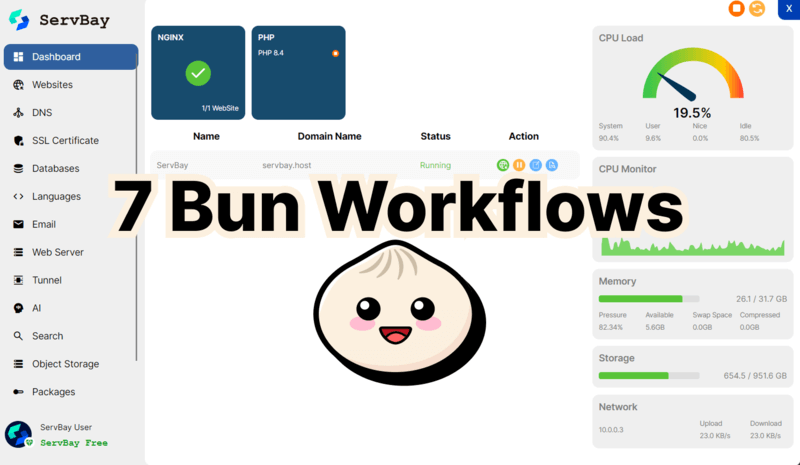When someone types npm install, laptop fans roar like a jet engine.
Bun changes that story. It combines a runtime, package manager,
bundler, and test runner into one lightning-fast binary. But
using Bun effectively takes more than just installation --- it requires
the right workflows.
Here are seven practical Bun workflows to help you write, test, and deploy apps faster and cleaner.
1. Run One-Off Commands with bunx
Forget globally installed CLI tools. They clutter your environment and
version management. Instead, bunx lets you run any package command
without installing it globally.
# Create a new Vite + React project without global installs
bunx create-vite@latest my-react-app --template react-ts
# Run ESLint and auto-fix issues
bunx eslint . --fixEveryone --- from your local machine to CI pipelines --- uses the exact same tool versions. No more “works on my machine” moments.
2. Use Reliable Lockfiles with bun install
bun install isn’t just fast; it ensures reproducible builds by
generating compact and consistent dependencies.
# Prevent accidental lockfile changes
bun install --frozen-lockfile
# Production install without devDependencies
bun install --productionCommit the bun.lockb binary lockfile to your repo and enable
--frozen-lockfile in CI to keep your dependency tree consistent across
all environments.
3. Simplify Monorepos with Bun Workspaces
Bun makes managing monorepos effortless --- no need for Nx or Lerna.
Just define your workspace structure in the root package.json:
{
"name": "super-app",
"private": true,
"workspaces": ["apps/*", "packages/*"],
"scripts": {
"dev": "bun run --filter \"./apps/*\" dev",
"build": "bun run --filter \"./packages/*\" build"
}
}Shared libraries under packages/ are instantly available to all apps
under apps/, streamlining multi-app development and versioning.
4. Combine Front-End and API in a Single Bun Server
Bun’s built-in HTTP server is small and fast. Using frameworks like Hono or Elysia, you can serve both your API and static front-end from the same process.
// server.ts
import { Hono } from "hono";
import { serveStatic } from "hono/bun";
const server = new Hono();
server.get("/api/users/:id", (ctx) => {
const { id } = ctx.req.param();
return ctx.json({ id, name: `User ${id}` });
});
server.use("/*", serveStatic({ root: "./public" }));
export default {
port: 8080,
fetch: server.fetch,
};Start it with:
bun --watch run server.tsYour API and client reload automatically as you code --- the dream setup for full-stack development.
5. Build Ultra-Fast Bundles with bun build
Bun’s bundler is extremely efficient for both client and server targets.
# Bundle client code for browsers
bun build ./src/main.ts --outdir ./dist/client --sourcemap --minify
# Bundle backend code for Bun or Node.js
bun build ./src/server.ts --target=bun --outdir ./dist/serverPerfect for microservices, cloud functions, or optimizing CI/CD build steps.
6. Test Instantly with bun test
Forget Jest configuration chaos. Bun’s built-in test runner works out of the box with TypeScript, parallel execution, and coverage.
// text-utils.test.ts
import { expect, test, describe } from "bun:test";
const toTitleCase = (text: string) =>
text ? text[0].toUpperCase() + text.slice(1) : "";
describe("toTitleCase()", () => {
test("capitalizes the first letter", () => {
expect(toTitleCase("world")).toBe("World");
});
test("returns empty string for empty input", () => {
expect(toTitleCase("")).toBe("");
});
});Run tests with:
bun testEnjoy blazing speed with built-in watch mode and coverage reports --- testing feels frictionless again.
7. Manage Environment Variables Without dotenv
Bun automatically loads .env files from the project root, no
dependencies required.
DATABASE_URL="postgresql://user:pass@localhost:5432/db"
JWT_SECRET="super-secret-key"Then simply access them in your code:
// config.ts
function requireEnv(key: string): string {
const val = Bun.env[key];
if (!val) throw new Error(`Missing environment variable: ${key}`);
return val;
}
export const env = {
db: requireEnv("DATABASE_URL"),
secret: requireEnv("JWT_SECRET"),
};This lightweight approach eliminates extra dependencies while enforcing safer configuration management.
⚠️ Pitfalls to Watch For
- Node.js module compatibility: Not all Node APIs or native C++ modules are supported.\
- CJS imports: Some legacy packages require
import pkg from 'old-lib'and then usingpkg.default.\ - Binary lockfiles:
bun.lockbmerges can’t be resolved manually; rerunbun installafter conflicts.
🧠 Takeaway
Bun is about integration --- bundler, test runner, package manager,
and runtime unified into one tool.
It replaces five separate utilities, cuts build times, and simplifies
project setup dramatically.
Start with ServBay to manage your Node and Bun versions easily, then dive into these workflows to experience true full-stack acceleration.
